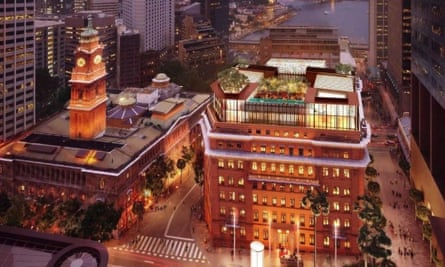The New South Wales opposition fears that the chief secretary’s office, one of Sydney’s finest sandstone buildings and home to the office of the “father of federation”, Sir Henry Parkes, could be sold – now that its key tenant is moving out.
The Berejiklian government announced on Friday that the NSW Industrial Relations Commission would move to Parramatta, but it has declined to say what will happen to the impressive colonial building the commission now occupies.
The ornate five-storey building, which stands at the junctions of Macquarie, Bridge and Phillip streets in Sydney, is the last significant sandstone building still being used as a government office.
Sign up to receive the top stories in Australia every day at noon
The NSW Treasury department on Macquarie Street was sold off in the 1980s and is now the Intercontinental hotel. The Lands Department and the Education department on Bridge Street have been leased by thestate government to a Singaporean developer, Pontiac Land group, which plans to turn them into a 240-bed luxury hotel.
While there are strict heritage controls, the buildings will no longer be as accessible to the public.
The GPO in Martin Place was sold by the federal government and Australia Post, and is now the Westin hotel.
“The chief secretary’s building is Sydney’s last great sandstone building remaining in public hands – we cannot allow it to go the way of our other great buildings and simply be flogged off by the mercenary Berejiklian government,” the opposition heritage spokeswoman, Penny Sharpe, said.
“The premier must rule out any sale or long-term commercial lease of this iconic site immediately. To the community’s disgust, all this greedy government sees is the profit to be made from the sale, and not the history and heritage that it represents – this building represents the heart of our colonial democracy,” she said.

The building was designed by colonial architect James Barnet and built in two stages. The first stage, involving levels one to four, was completed between 1873 and 1881. The second stage, designed by Walter Liberty Vernon, was completed between 1894 and 1896, when the mansard at level 5 and the dome were added.
The building was the seat of colonial administration, and has been used continuously by the NSW government.
“From here, Sir Henry Parkes advanced the case for federation and the vote for Australia’s women,” the historian Stephen Dando-Collins wrote in Sir Henry Parkes: The Australian Colossus.
Parkes’ office had a staircase hidden behind a bookcase that led to tunnels that went to the old Treasury building, the police courts and Circular Quay, where the five-time premier of NSW would, according to legend, dispatch his mistresses.
The director of conservation at National Trust NSW, Graham Quint, said the trust’s position was that government buildings such as this one should stay in government hands.
“Our position is it should stay a government building. We certainly don’t want to see public debate on its future pre-empted by a behind-the-scenes decision to turn it into a hotel,” he said.
A Property NSW official said: “The chief secretary’s building is one of the state’s most important heritage assets and the preservation of its heritage significance will be central to any decision regarding its future use.
“No decisions have been made on the future use of the building.”
In a speech to mark the 40th anniversary of the Heritage Act last year, the NSW Labor leader, Luke Foley, committed to preserving the chief secretary’s building and moving the premier’s office and the cabinet room to the building if elected in 2019.
Labor says the NSW government has now sold more than $9bn worth of public property, with reckless disregard for the cultural heritage of the state.
